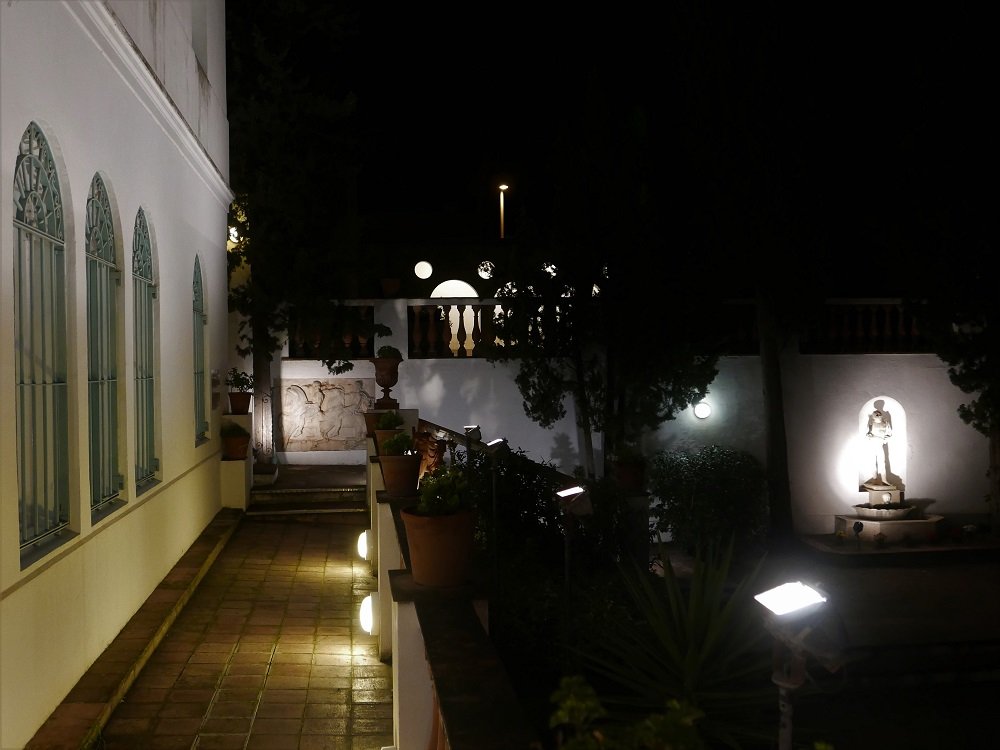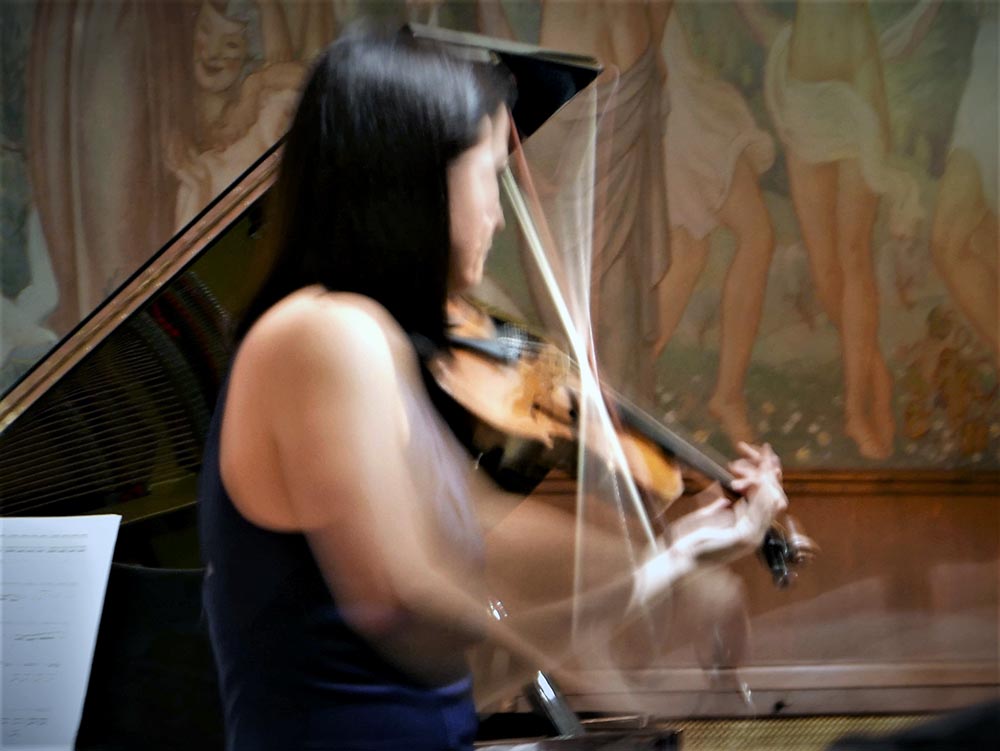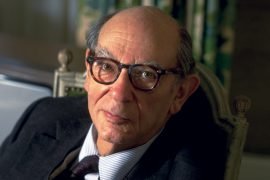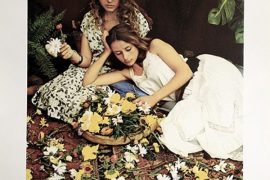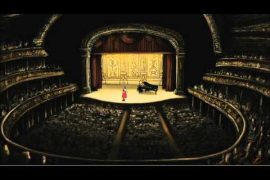[dropcap letter=”T”]
he Casa Bartomeu, built according to the style known as Noucentisme, currently the quarters of the Catalan Council of Music and the Jardí dels Tarongers association, hosts chamber music evenings that transport the listener to another era. The era in which Josep Maria Bartomeu (1888-1980) promoted the musical activity of the city of Barcelona by premiering works, such as the Quartet de Pedralbes by Manuel Blancafort, and accompanying the career of first-rate performers, among which Victoria de los the Angeles. The commitment to the arts, in difficult decades, has managed to transcend Bartomeu’s time of life, since his donation to the Barcelona City Council of that privileged house -“markedly Mediterranean style”- was set under the condition of perpetuating the diffusion of music. A reality undertaken by the current project, inaugurated in 2014, which has different cycles.
INTERIORITIES THAT MEET IN INTERIORS
A sentence that sounds like an invitation summarizes that spirit, whose validity is not only archaeological, but inherent in the emotions that are by awaken the aesthetic experience: “we offer music lovers the opportunity to live intimate musical sessions that move”. Music is not only enjoyed outdoors in the Jardí dels Tarongers, during the warmer seasons, as in the case of the magnificent concert by Bandart i la Jove Orquestra Nacional de Catalunya. In the autumn and winter cycles you can rediscover the magic of the interpretation of chamber music in an interior with paintings by Antoni Vila i Arrufat, in such a close proximity to artists that today is unknown, a fact that brings the listener back to past centuries.
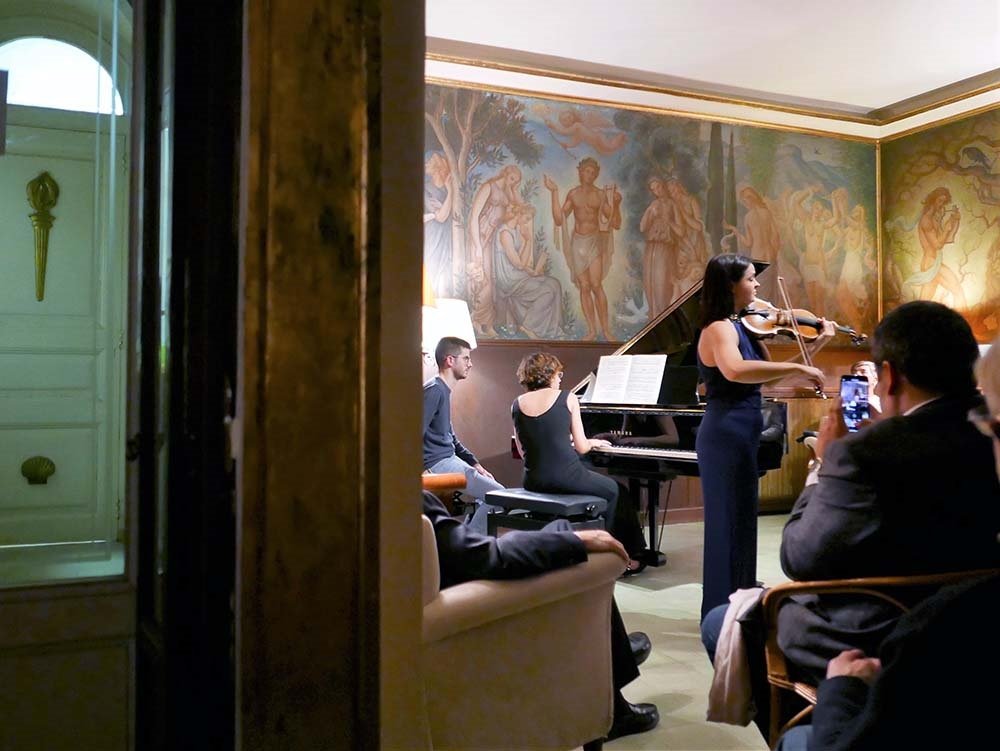
Even if the recreation of the interpretative conditions on the part of the ancient music has made possible an approximation to the aesthetics of the corresponding epochs, those works are seldom heard in the type of rooms for which they were thought: rooms or halls much smaller than the current auditoriums, even that their respective chamber rooms. The presence of the instrument, the way in which the sound occupies the space and affects the listener who is found himself inside of it, together with the artist, is qualitatively different. Neither the common and insurmountable distance nor the obligatory impersonality is there, characteristics that -on may suppose- contribute to a much more intense aesthetic experience, similar to that of the most famous domestic musical evenings, the Schubertiades.
Thus, Jardí dels Tarongers becomes the stage for a practically extinct proximity. To be side by side with the artist, at a short distance from the interpretation of a work that feels so close to the inner self, that seems to resonate within. Actually, chamber music is not just music made with few instruments, it is music that interpellates the interiorities that are sharing the same space. This very exclusive experience is, in fact, open to everyone. In exchange for the payment of a symbolic amount, the possibility of a genuine experience is offered, the attendance to recitals that usually do not reach the hour of duration. This fact still allows important pieces to be interpreted, following the tradition imposed by the patron, who programmed such fundamental, progressive and disparate works as the Orfeo, by Claudio Monteverdi, Socrate, by Erik Satie or the Gurrelieder by Arnold Schönberg.
Chamber music is not only the kind of music made with few instruments, but music that interpellates those interiorities that are sharing the same space
It is, in short, a friendly format, whose closeness culminates with the possibility of sharing a glass of cava, after the interpretation, with the young artists. Musicians at the start of their promising careers, and excellently willing to squeeze the opportunity of the live experience. Many of them do not take long to consolidate, with little surprise we discover them, shortly, programmed in larger and more recognized scenarios, and inevitably at a greater distance from the viewer. We think -to mention only three– of names like Sara Blanch, who will sing at the Gran Teatre del Liceu this December, the charismatic pianist Carles Marigó or flutist Elisabet Franch, who recently debuted at Carnegie Hall. They all passed through El Jardí dels Tarongers.
INTERPRETERS AND POSSESSED SPECTATORS
An excellent example of the evocation that provokes a musical experience of this kind was the last recital on November 30th, with the participation of Maria Canyigueral, on the piano, and Lana Trotovsek, whose violin, created around 1750, captivated the present. A sort of magnetism -or simply the sound vibration, tuned with Pythagorean neatness- expands in the vicinity of the source that generates it. The energy does not travel far, it rather condenses in situ, between the walls of the Vila i Arrufat room thanks to the convenient acoustics. Both the Catalan and Slovenian artists know the main pieces of the repertoire for violin and piano, and in fact they are currently immersed in the project of recording the sonatas integral of Beethoven, being the fifth -“Spring”, one of the most attractive- included in the program of the evening.
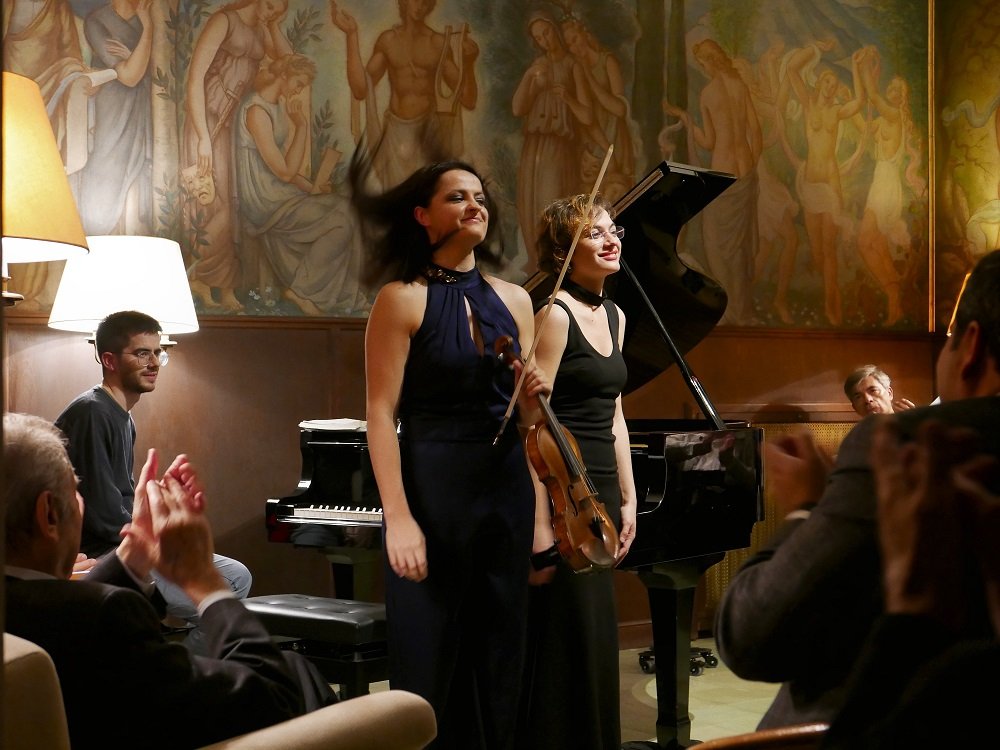
But, above all, stands the ninth, the “Kreutzer” sonata, increased in significance by the demonic fame that was assigned retrospectively, according to the homonymous story of Tolstoy. Appeared in 1889, it illustrates how the complicity between a pianist and the violinist who accompanies her in the execution of that piece derives in a relationship of adultery, against the established morals, that provokes an intense suffering in the husband, who ultimately acts as a sour narrator, reaching the end of an inspired madness: “This sonata is terrible, especially this part (…) What is that? I do not get it. What does it produce? And why does it produce such an effect? It is said that music influences in such a way that it elevates the spirit. Nonsense, a lie! That’s right, it has an effect, a terrible effect (…) Music makes me forget about myself, about my real situation, it moves me to another situation”.
Chamber music impacts on the intimacy of the protagonists of many of the best fictions -also the cinematographic ones- that are assumed as real by the participation of the readers / spectators. In this sense, both the sentimental improvements and the blunders and misfortunes of Barry Lyndon seem, in Stanley Kubrick’s film, unfailingly governed by the beautiful Andante con moto of the Piano Trio in E flat major, op. 100, by Franz Schubert. A minimalist piece in terms of instrumental resources, and thanks to that, perhaps -to the good work of Schubert / Kubrick- its impact is maximum on the listener / spectator, feeling intimately linked to the plot; to the vital display that reflects the glory and misery of a single individual in his struggle to enter the high society. The internal movement of emotions, the transformation experienced by the protagonists is evident also in the gambling scene:
Even if the use of that movement by Kubrick is not chronologically proper -because the work was composed by Schubert in 1827, shortly before his death, and not in the eighteenth century- in the movie it works brilliantly. Over the discreet advance of the piano, the cello theme rises and draws a solemn and emotive filigree, which -one would say- it establishes for life in the deep strata of our psyche, as if it had always been there. The piece goes on, nevertheless. The relationships between instruments are then reversed, enriched by the entrance of the violin and the dramatic series of questions and answers that Schubert suggests, and with which Kubrick expresses the swing, the tremendous and yet beautiful fragility of the protagonist.
Both the sentimental improvements and the blunders and misfortunes of Barry Lyndon seem unfailingly governed by the beautiful Andante con moto of Franz Schubert’s trio.
Many of the psychological details are perceived by means of the empathy inherent in the process of identification with the character, but also thanks to the feeling that emanates from the musicality associated with him. Felix Mendelssohn wrote a series of pieces for piano titled Songs without words, highlighting in a letter addressed to his sister Fanny -in fact, it is believed that she collaborated in the compositional task- the greater precision of the music, in contrast to the false determination and semantic security of the concepts. Without words, with silences or through the ellipsis one can understand everything. Let’s think of the role of music in a film like In the Mood for Love, by Wong Kar-Wai, in which a man and a woman who have been betrayed by their respective partners live side by side, keep company and give consolation, feeling inevitably the possibility of a love that (despite one’s desires) will not happen.
Music invites to conc eive the reality of an attraction that is not visibly expressed, only in the mind of the spectator / listener in terms of hyper-aesthetic images and, above all, a soundtrack full of contrasts (Nat King Cole’s Quizás, quizás quizás), in which that Andante theme is recurrently imposed: a melody for string marked by pizzicato counterpoint, beat that marks the progress in parallel of both individuals. The effects of musical complicity occur spontaneously through the understanding of the performers / actors, engaged with the same cause. Similarly, and far from its apparent passivity, the spectator of cinematographic fictions becomes a second-degree interpreter by participating in the meaning of the sound fact, whose reality interweaves a plot that can never be completely foreign to him.
“WORLDLY “LIFE, FROM PROUST TO LA GRANDE BELLEZZA
The last artists to perform at the Jardí dels Tarongers -Lana Trotovsek and Maria Canyigueral- dedicated an excellent and successful recording (award-winning) to a sonata no less literary than the Kreutzer. Namely, the Sonata in A major by César Franck, one of the possible inspirers of the fictional “Sonata de Vinteuil” -referred in Marcel Proust’s Un amour de Swann– and famous for “the little phrase” that brings together the characters in love. The explanation of the soul-gathering around that music may seem somewhat phony; the path of kitsch aesthetics is tempted -in an absolutely premeditated way by Proust- as with the allusion to the sexual act by the reference to the Cattleya orchid, favorite of the demi-mondaine Odette de Crecy. Not in vain does the love-passion of the main character imply a fall, which he will only recognize at the last moment, when Swann knows himself free from the biochemical cocktail that intoxicates and confuses the senses, recognizing that, in fact, she was not his type (pas mon genre).
“It was like the beginning of the world, as if there had been only the two of them on earth, or rather in this world closed to everything else, built by the logic of a creator and where nobody else would ever be: this sonata”.
Until then, what is given is the experience of a temporal simultaneity, which music seals and elevates platonically. Proust does not fall short in his attempt to exploit, by means of images and comparisons, what music provokes: “At first the solitary piano complained, like a bird abandoned by her companion; the violin heard him, answered him from a nearby tree. It was like the beginning of the world, as if there had been only the two of them on earth, or rather in this world closed to everything else, built by the logic of a creator and where nobody else would ever be: this sonata”. This sonata -César Franck’s- is a cyclic one, having a theme that is enunciated, transformed and rediscovered, effectively: instruments enjoy themselves in mirror games with punctuality and dynamism, like two lovers who look each other in the eyes and recognize themselves alone in a newly constituted world, who end sentences previously initiated by the other or simultaneously give responses that only they understand as identical.
The passage of the sonata referred to in the Proustian fiction -included in the first volume of the A recherche du temps perdu, despite its relatively independent configuration as a novel- could be found in the Allegretto poco mosso, closing movement, but the suggestion permits other “recognitions”, without going any further in any of the ecstatic passages of Ben moderato: Recitativo-Fantasia. However, what this music really means is something that no one can determine beyond its own experience, beyond the feelings it awakens, associated with experiences really lived or reveries endowed by a mythical aftertaste. The feedback of both spheres -reality and fantasy- constitutes, in fact, the foundation of an emotionality that is updated in the course (and with the accumulation) of aesthetic experiences; that stimulates the feeling in a kind of perfect present, whose foundation would seem to be in another life.
Strolling through the gardens of the Casa Bartomeu at night, getting lost in the outskirts of a remote world or enjoying the interiority of music, refers to a search for meaning that is felt as lost from its origins. La Grande Bellezza, by Paolo Sorrentino, has taught us that the attempts that come afterwards -that happen in time- are mere simulacra that rise or lower human condition. Divine or degrading celebrations. Vain efforts to return to feel ç for the first time an excess of fire in the interior; that distant infatuation -which is often musically induced- that the reader or spectator of fictions experiences as a consolation. A mythical past, immemorial, enables memory and stings in a way that is not always appreciated. The “world of yesterday”, to which the good of Jep Gambardella goes back, is not the world governed by supposedly unshakeable values and reckless geopolitical decisions. It is the world of desiring interiority in which the wonder and desire is born.
In the “Gambardella case”, an original infatuation affirms itself impenitently, adhering to the phantasmatic image of a being that can never be possessed. The reality of desire as ecstatic joy is inaugurated as a trauma; a rupture that has no return, insofar as it delays ad eternum its possible reparation -the realization of desire- displaced beyond time. “You’ll never have me” the double-protagonist of Lost Highway Carretera had whispered to her friend after making love, in a psychotic and inspired recreation of what had been experienced decades before by the protagonist of Vertigo. A qualitatively different space-time has to welcome and bear fruit the revelation of pure and unconditional beauty, that form of ardent and savior love that protects the one affected by feeling, and that -some people say- we will find again at the end of our days, when there is no time. Or maybe when, finally, the novel begins.
